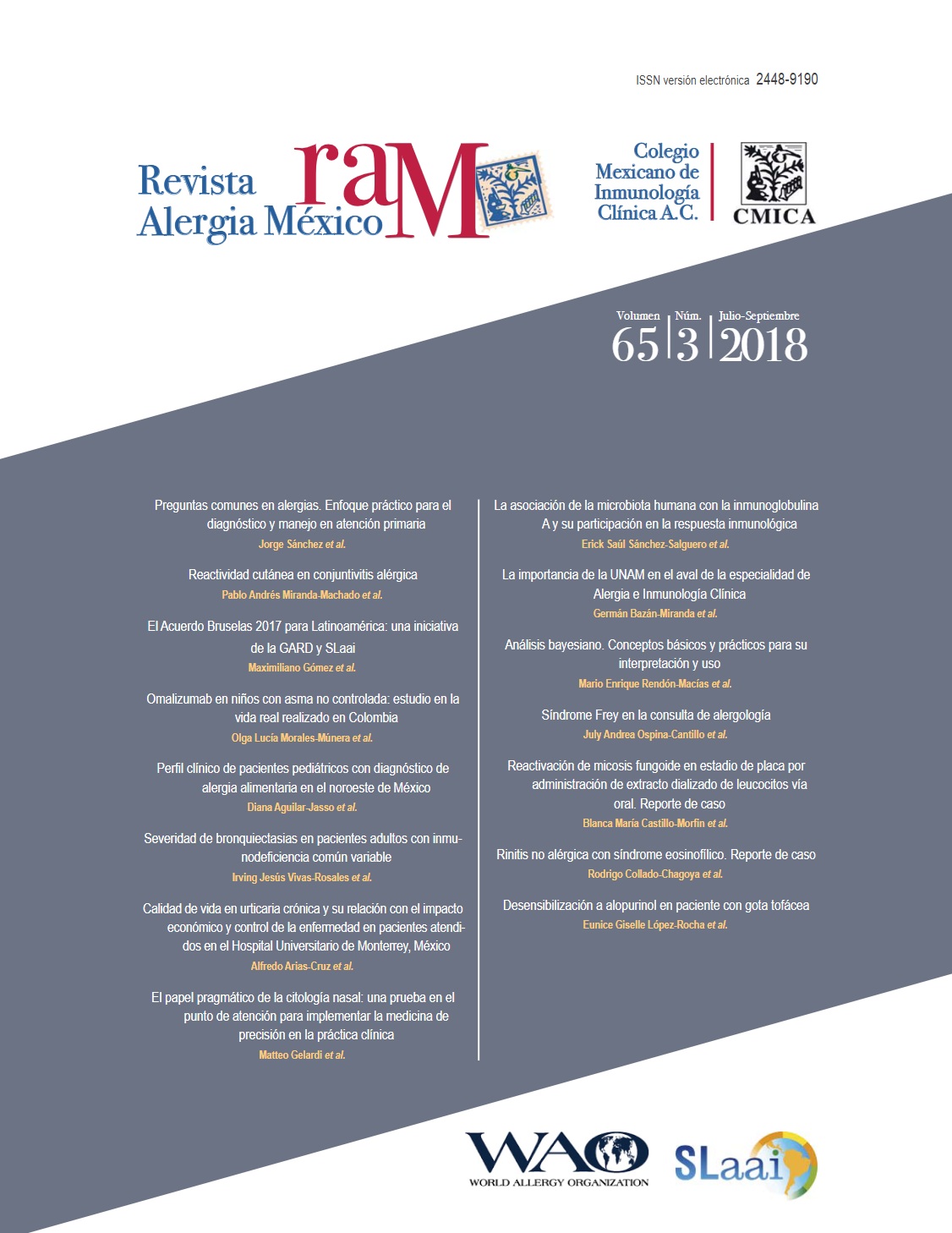Resumen
Antecedentes: La alergia alimentaria es una reacción adversa secundaria a una respuesta inmune específica tras la exposición a un alimento. Conocer el curso natural de las alergias alimentarias es esencial para el diagnóstico y tratamiento oportunos.
Objetivo: Conocer el perfil clínico de niños con diagnóstico de alergia alimentaria, atendidos en el servicio de alergología pediátrica de un hospital de segundo nivel.
Métodos: Estudio transversal de expedientes de niños con diagnóstico confirmado de alergia alimentaria. Se estudió tipo de alergia alimentaria, cuadro clínico inicial, antecedentes de atopia familiar, tiempo de alimentación al seno materno, edad de ablactación, alimentos alérgenos positivos por paciente, entre otros. Se realizó análisis descriptivo y búsqueda de asociación con chi cuadrada.
Resultados: De 95 pacientes estudiados, predominaron las mujeres. Leche, soya, trigo y huevo fueron los alimentos con más respuestas alérgicas. Las manifestaciones clínicas más comunes fueron gastrointestinales. El tiempo de inicio de los síntomas al diagnóstico definitivo fue de 3.2 años. La alergia alimentaria se asoció con edad de ablactación ≥ 6 meses; leche y soya con sintomatología respiratoria y gastrointestinal, huevo con respiratoria y dermatológica y trigo con gastrointestinal.
Conclusiones: Las alergias alimentarias se manifestaron principalmente con síntomas gastrointestinales y existió asociación entre cuadro clínico y alimentos alérgenos.
Referencias
Medina-Hernández A, Huerta-Hernández R, Góngora-Meléndez M, Domínguez-Silva G, Mendoza-Hernández DA, et al. Perfil clínico-epidemiológico de pacientes con sospecha de alergia alimentaria en México. Estudio Mexipreval. Rev Alerg Mex. 2015;62:28-40.
Puente-Fernández C, Maya-Hernández R, Flores-Merino M, Romero-Figueroa MS, Barajas M, Domínguez-García MV. Self-reported prevalence and risk factors associated with food hypersensitivity in Mexican young adults. Ann Allergy Asthma Immunol. 2016;116(6):523-527. DOI: 10.1016/j.anai.2016.03.010
Alkazemi D, Albeajan M, Kubow S. Early Infant feeding practices as possible risk factors for immunoglobulin e-mediated food allergies in Kuwait. Int J Pediatr. 2018;2018:1701903. DOI: 10.1155/2018/1701903
Sharma HP, Bansil S, Uygungil B. Signs and symptoms of food allergy and food-Induced anaphylaxis. Pediatr Clin North Am. 2015;62(6):1377-1392. DOI: 10.1016/j.pcl.2015.07.008
Burks AW, Tang M, Sicherer S, Muraro A, Eigenmann PA, Ebisawa M, et al. ICON: food allergy. J Allergy Clin Immunol. 2012;129(4):906-920. DOI: 10.1016/j.jaci.2012.02.001
Bedolla-Barajas M, Bedolla-Pulido TR, Camacho-Peña AS, González-García E, Morales-Romero J. Food hypersensitivity in Mexican adults at 18 to 50 years of age: a questionnaire survey. Allergy Asthma Immunol. 2014;6(6):511-516. DOI: 10.4168/aair.2014.6.6.511
Sicherer SH, Sampson HA. Food allergy: epidemiology, pathogenesis, diagnosis, and treatment. J Allergy Clin Immunol. 2014;133(2):291-307. DOI: 10.1016/j.jaci.2013.11.020
Moussa-Afify S, Pali-Schöññ I. Adverse reactions to food: the female dominance-A secondary publication and update. World Allergy Organ J. 2017;10:43. DOI: 10.1186/s40413-017-0174-z
Elbert NJ, Kiefte-De-Jong JC, Voortman T, Nijsten TEC, De-Jong NW, Jaddoe VW, et al. Allergenic food introduction and risk of childhood atopic diseases. PLoS One. 2017;12(11):e0187999. DOI: 10.1371/journal.pone.0187999
Kattan J. The prevalence and natural history of food allergy. Curr Allergy Asthma Rep. 2017;16(7):16-47. DOI: 10.1007/s11882-016-0627-4
Rosas MR. Alergia e intolerancia alimentaria. Ámbito Farmacéutico Nutrición. 2006;25(7):56-59.
Doğruel D, Bingöl G, Altıntaş DU, Yılmaz M, Güneşer-Kendirli S. Clinical features of food allergy during the 1st year of life: the ADAPAR birth cohort study. Int Arch Allergy Immunol. 2016;169(3):171-180. DOI: 10.1159/000444639
Wood RA. The natural history of food allergy. Pediatrics. 2003;111(6 Pt 3):1631-1637.
Hoz B. Etiopatogenia. En: Hoz B, Dordal T, Enrique E. Alergias respiratorias 2020. España: Euromedice; 2012.
Bedolla-Barajas M, Alcalá-Padilla G, Morales-Romero J, Camacho-Fregoso J, Rivera-Mejía V. Peanut allergy in Mexican children: what is the effect of age at first consumption? Iran J Allergy Asthma Immunol. 2016;15(1):53-61.
Chinthrajah RS, Hernandez JD, Boyd SD, Galli SJ, Nadeau KC. Molecular and cellular mechanisms of food allergy and food tolerance. J Allergy Clin Immunol. 2016;137(4):984-997. DOI: 10.1016/j.jaci.2016.02.004
Bedolla-Barajas M, Bedolla-Pulido TR, Macriz-Romero N. Prevalence of peanut, tree nuts, sesame, and seafood allergy in Mexican adults. Rev Invest Clin. 2015;67(6):379-386.
Savage J, Sicherer S, Wood RA. The natural history of food allergy. J Allergy Clin Immunol Pract. 2003;4(2):196-203. DOI: 10.1016/j.jaip.2015.11.024
Supo J. Chi cuadrada prueba de independencia [Internet]. Peru: Bioestadístico; 2011 [Consultado 2012 Aug 16]. Disponible en: http://bioestadistico.com/chi-cuadrado-prueba-de-independencia

Esta obra está bajo una licencia internacional Creative Commons Atribución-NoComercial 4.0.
Derechos de autor 2018 Revista Alergia México

